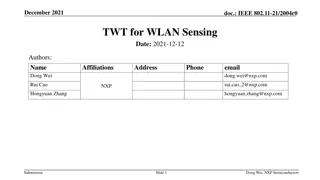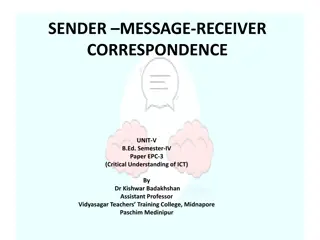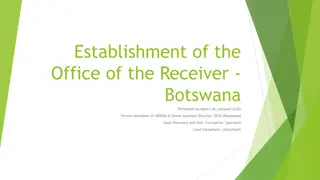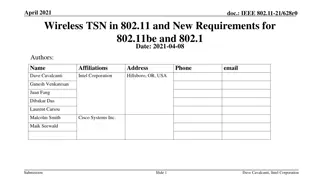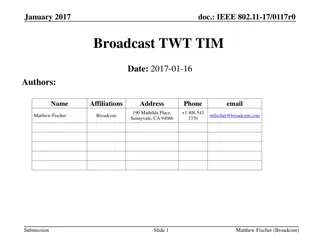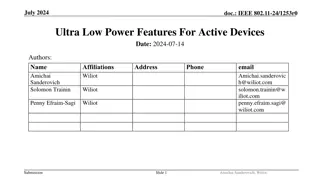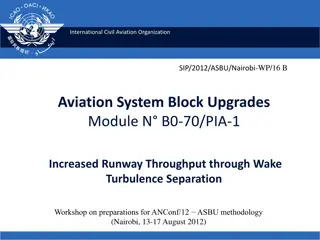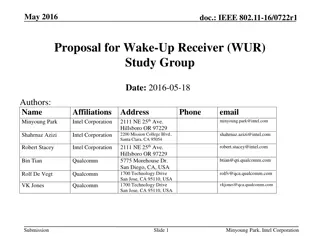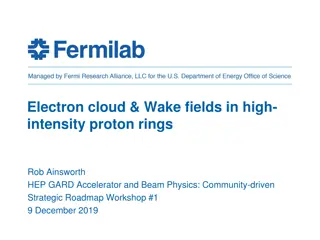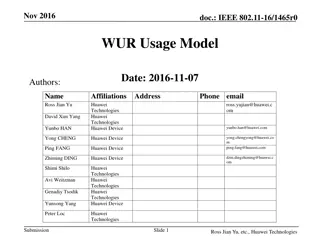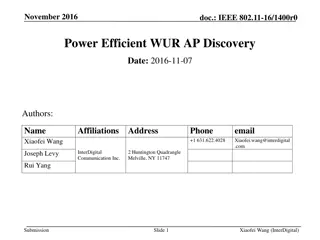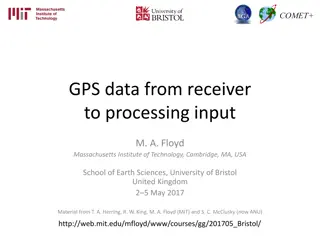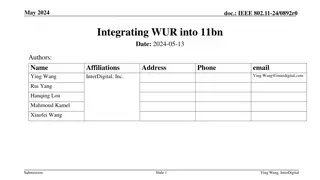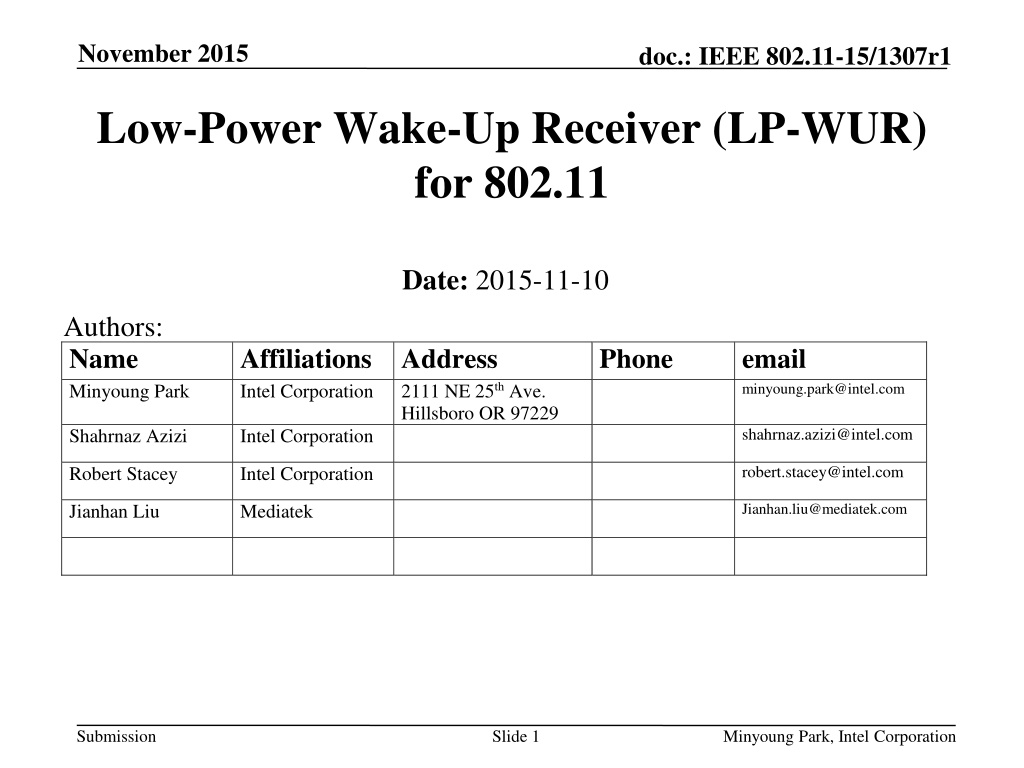
Low-Power Wake-Up Receiver (LP-WUR) for IEEE 802.11
Explore the design and operation of a Low-Power Wake-Up Receiver (LP-WUR) developed to address the conflicting goals of low power consumption and low latency for IEEE 802.11, solving the duty-cycle trap and enhancing Internet-of-Things (IoT) use cases. This innovative solution acts as a companion radio to the main 802.11 radio, enabling efficient data transmission and reception with minimal power consumption.
Download Presentation

Please find below an Image/Link to download the presentation.
The content on the website is provided AS IS for your information and personal use only. It may not be sold, licensed, or shared on other websites without obtaining consent from the author. If you encounter any issues during the download, it is possible that the publisher has removed the file from their server.
You are allowed to download the files provided on this website for personal or commercial use, subject to the condition that they are used lawfully. All files are the property of their respective owners.
The content on the website is provided AS IS for your information and personal use only. It may not be sold, licensed, or shared on other websites without obtaining consent from the author.
E N D
Presentation Transcript
November 2015 doc.: IEEE 802.11-15/1307r1 Low-Power Wake-Up Receiver (LP-WUR) for 802.11 Date: 2015-11-10 Authors: Name Minyoung Park Affiliations Address Intel Corporation Phone email minyoung.park@intel.com 2111 NE 25th Ave. Hillsboro OR 97229 shahrnaz.azizi@intel.com Shahrnaz Azizi Intel Corporation robert.stacey@intel.com Robert Stacey Intel Corporation Jianhan.liu@mediatek.com Jianhan Liu Mediatek Submission Slide 1 Minyoung Park, Intel Corporation
November 2015 doc.: IEEE 802.11-15/1307r1 Abstract This presentation introduces a low-power wake-up receiver (LP-WUR) design that enables low power consumption and low latency for 802.11. Submission Slide 2 Minyoung Park, Intel Corporation
November 2015 doc.: IEEE 802.11-15/1307r1 Problem: Escaping the Duty-Cycle Trap With duty-cycled operation, low power consumption and low latency are conflicting goals To increase battery life, a device needs to sleep more increased latency To receive data with low latency, a device needs to sleep less shorter battery life Goal Low latency Sleep less (but short battery life) battery life Long battery life (but long latency) Sleep more latency Submission Slide 3 Minyoung Park, Intel Corporation
November 2015 doc.: IEEE 802.11-15/1307r1 Problem: Internet-of-Things (IoT) Use Case Today without LP-WUR User cannot access the IoT device while the IoT device is off to save power Internet Waits until IoT device wakes up (worst case = 1 hour) Access Point Access Point command User IoT device Configuration change command (e.g. collect data every 10 min) OFF ON (wakes up every 1 hour) Submission Slide 4 Minyoung Park, Intel Corporation
November 2015 doc.: IEEE 802.11-15/1307r1 Solution: Low-Power Wake-Up Receiver (LP-WUR) as Companion Radio for 802.11 Comm. Subsystem = Main radio (802.11) + LP-WUR Main radio (802.11): for user data transmission and reception Main radio is off unless there is something to transmit LP-WUR wakes up the main radio when there is a packet to receive User data is transmitted and received by the main radio LP-WUR: not for user data; serves as a simple wake-up receiver for the main radio LP-WUR is a simple receiver (doesn t have a transmitter) Active while the main radio is off Target power consumption < 100 W in the active state Simple modulation scheme such as On-Off-Keying (OOK) Narrow bandwidth (e.g. < 5 MHz) Target transmission range: LP-WUR = Today s 802.11 Submission Slide 5 Minyoung Park, Intel Corporation
November 2015 doc.: IEEE 802.11-15/1307r1 Design and Operation of LP-WUR Transmission range 802.11 = LP-WUR or Data Packet Receiver Transmitter 802.11 802.11 802.11 802.11 ON OFF ON OFF + 802.11 Wake-up Packet Wake-up signal LP-WUR ON Wake-up Packet Extremely low power receiver design (< 100 uW) - Small and simple OOK demodulator 802.11 preamble for coexistence - Use L-SIG to protect the packet - This is for 3rd party legacy stations - This is not decoded by LP-WUR (L-SIG: legacy SIGNAL field) Payload modulated with On-Off Keying (OOK) - Payload = [Wakeup preamble | MAC header (Receiver address) | Frame body | FCS] - OOK modulation can be done using OFDM transmitter with modification (OFDM: orthogonal frequency division multiplexing; FCS: frame check sequence) Submission Slide 6 Minyoung Park, Intel Corporation
November 2015 doc.: IEEE 802.11-15/1307r1 IoT Use Case Proposed scheme using LP-WUR User can access the IoT device with low latency and the IoT device can have long battery life Internet Access Point Access Point Wake-up Packet command User IoT Device Configuration change command (e.g. collect data every 10 min) OFF ON (wakes up every 1 hour) Submission Slide 7 Minyoung Park, Intel Corporation
November 2015 doc.: IEEE 802.11-15/1307r1 LP-WUR Designs from University and Industry Tech CMOS (nm) Active area (mm2) Frequency (GHz) Power ( W) Sensitivity (dBm) Rate (kbps) Publications Modulation CICC [2007] UC Berkeley 1.9 OOK 65 -50 40 90 0.16 ISSCC [2008] UC Berkeley 2 OOK 52 -72 100 90 0.1 VLSI[2014] Panasonic 0.925 OOK/FSK* 45.5 -87 50 65 1.27 JSSC[2014] - IMEC 0.78-0.915 OOK 123 -86 10 90 1.27 *) FSK: frequency-shift keying References: CICC [2007] : N. Pletcher, S. Gambini, and J. Rabaey, A 65 W, 1.9 GHz RF to Digital Baseband Wakeup Receiver for Wireless Sensor Nodes, IEEE Custom Integration Circuits Conference (CICC), 2007. ISSCC [2008]: N. Pletcher, S. Gambini, and J. Rabaey, A 2 GHz 52 W Wake-Up Receiver with -72 dBm Sensitivity Using Uncertain-IF Architecture, IEEE International Solid-State Circuits Conference, 2008. VLSI [2014]: T. Abe, and et. al., An Ultra-Low-Power 2-step Wake-Up Receiver for IEEE 802.15.4g Wireless Sensor Networks , Symposium on VLSI Circuits Digest of Technical Papers, 2014. JSSC[2014]: X. Huang, and et. al., A 780-950 MHz, 64-146 W Power-Scalable Synchronized-Switching OOK Receiver for Wireless Event-Driven Applications, IEEE Journal of Solid-State Circuits, Vol.49, No.5, May 2014. Submission Slide 8 Minyoung Park, Intel Corporation
November 2015 doc.: IEEE 802.11-15/1307r1 Usage Model 1: Quick Message/Incoming Call Notification Scenario (2) With LP-WUR (1) Without LP-WUR AP buffers data until the client wakes up Internet Internet message message message or message + Wake-up packet Sleep/wake periodically Sleep until wake-up packet is received or or 802.11 802.11+LP-WUR Wake-up upon reception of wake- up packet and receive message Main radio needs to wake up periodically to receive a notification within a latency requirement Submission Slide 9 Minyoung Park, Intel Corporation
November 2015 doc.: IEEE 802.11-15/1307r1 Usage Model 2: Quick Status Query/Report, Configuration Change Scenario (1) Without LP-WUR (2) With LP-WUR Internet AP buffers data until the IOT device wakes up Internet Configuration change command Status query command Status query command or Configuration change command Status query command or AP AP Status query command + Status report Wake-up packet Sleep/wake periodically Sleep IOT device 802.11+LP-WUR IOT device 802.11 Submission Slide 10 Minyoung Park, Intel Corporation
November 2015 doc.: IEEE 802.11-15/1307r1 Comparisons: Legacy 802.11 Power Save Modes versus LP-WUR Scenario: data packet interval > polling interval (=latency requirement) Packet Interval (> Polling Interval) power save modes Channel access delay STA active to receive a beacon frame Legacy 802.11 PS-Poll B P A D A D A B B Beacon Interval (= polling interval) U-APSD D A D A N A N A Polling interval Target Wake Time (TWT) TWT TWT D A D A N A N A Time schedule interval Wake-up packet LP-WUR Proposed LP-WUR W D A D A LP-WUR off LP-WUR on LP-WUR on 2mS with TWT LP-WUR W D A D A LP-WUR on LP-WUR off LP-WUR on A Ack N Null-Data W Wake-up packet B Beacon P PS-Poll D Data 802.11 radio in active state (U-APSD: unscheduled automatic power save delivery) Submission Slide 11 Minyoung Park, Intel Corporation
November 2015 doc.: IEEE 802.11-15/1307r1 TGax Power Consumption Model Doc. 11-14/1444r2 [C. Yu, MediaTek] Doc. 11-15/1100r2 [C. Ghosh, Intel] Submission Slide 12 Minyoung Park, Intel Corporation
November 2015 doc.: IEEE 802.11-15/1307r1 Comparison Using TGax Power Consumption Model Latency requirement: 100mS Parameters Values Wake-up packet length 500 S Legacy power save modes LP-WUR power consumption in active state 100 W 1.6 mW ~15x LP-WUR active time duration 2 mS LP-WUR always on Channel access delay 1.5 mS 105 W ~224x 802.11 PHY rate (data/control) 6.5 Mbps LP-WUR duty-cycled (2 mS active every 100 mS) Data packet size 238 bytes 7 W Beacon/polling interval 100 mS Submission Slide 13 Minyoung Park, Intel Corporation
November 2015 doc.: IEEE 802.11-15/1307r1 Comparison Summary LP-WUR shows significant power saving over legacy power save modes Power saving gain : 7x (@5sec latency)~224x (@100mS latency) LP-WUR enables a long battery life and low latency with a small battery Submission Slide 14 Minyoung Park, Intel Corporation
November 2015 doc.: IEEE 802.11-15/1307r1 Overview of LP-WUR for 802.11 [Wake-up packet transmitter] (1) Transmit a wake-up packet [Wake-up packet design] (1) Designed to coexist with 802.11 (2) Simple modulation scheme (OOK) for low power receiver design (3) New packet format design [LP-WUR receiver design] (1)Small and simple OOK demodulator only decodes OOK modulated payload (2)Active power consumption < 100 uW (3)Meet 802.11 receiver performance requirements: e.g. minimum sensitivity = -82dBm (MCS0), PER<=10% Submission Slide 15 Minyoung Park, Intel Corporation
November 2015 doc.: IEEE 802.11-15/1307r1 Comparison between LP-WUR and LRLP LP-WUR LRLP (long-range low-power) LP-WUR wakes up the 802.11 radio when it receives a wake-up packet User data is transmitted and received by the 802.11 radio User data is transmitted and received by a new LRLP PHY/MAC User data transmission and reception Average power consumption Latency Data transmission rate Peak/average power consumption Transmission range Metrics Submission Slide 16 Minyoung Park, Intel Corporation
November 2015 doc.: IEEE 802.11-15/1307r1 Summary Today s 802.11 makes trade-offs between low power consumption and low latency The proposed LP-WUR technique can enable low power consumption and low latency at the same time A simple modulation scheme such as OOK can enable a low power receiver design Our study shows significant gain can be achieved using LP-WUR over legacy 802.11 power save modes Submission Slide 17 Minyoung Park, Intel Corporation
November 2015 doc.: IEEE 802.11-15/1307r1 Straw Poll Do you support the basic concept of the LP-WUR technique in this presentation for standardization in the 802.11WG? Y: 65 N: 1 A: 51 Submission Slide 18 Minyoung Park, Intel Corporation


